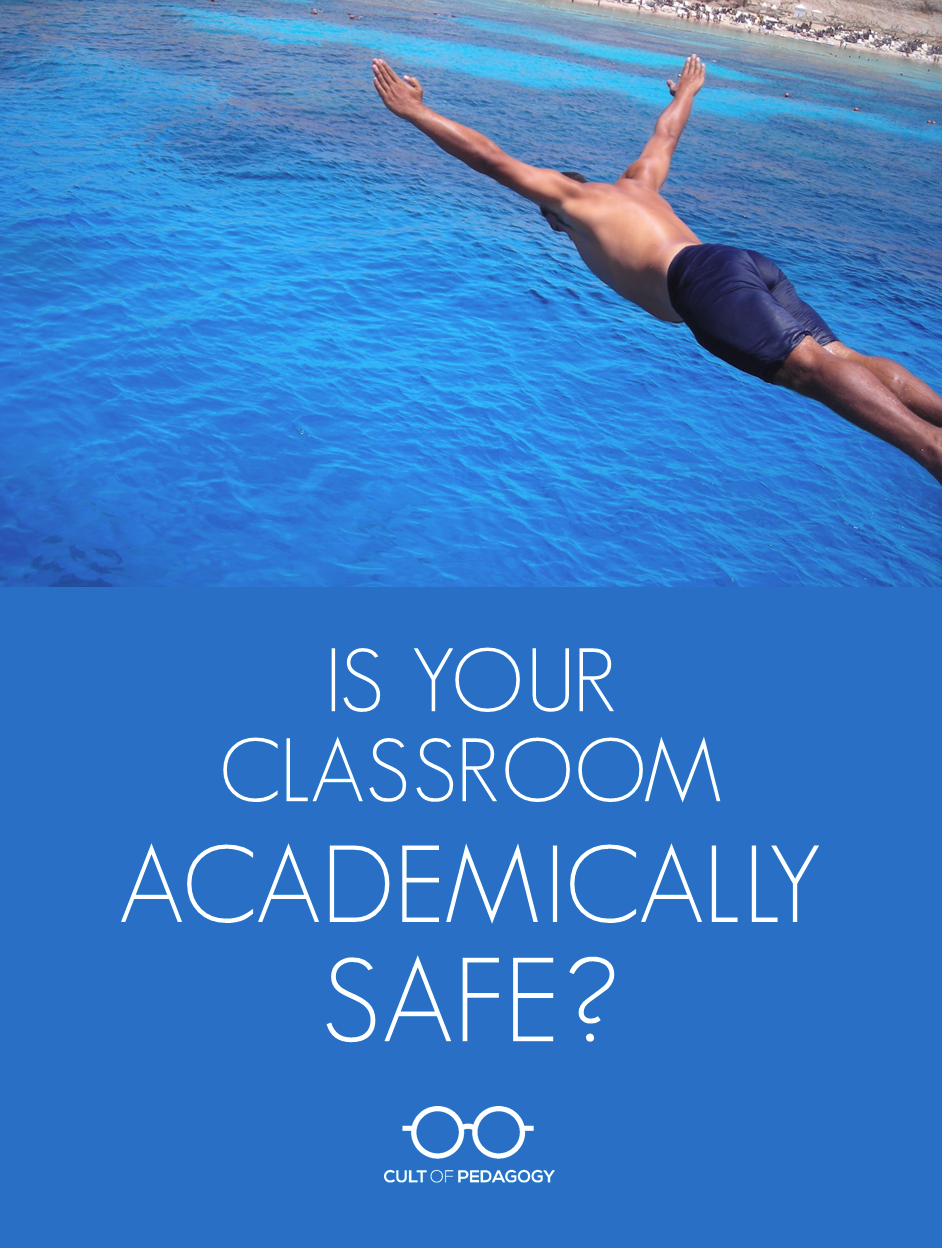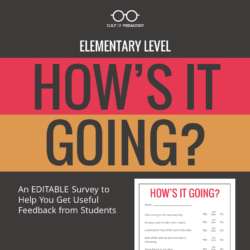
“Diving” by Khalid Mir is licensed under CC BY 2.0
Listen to this post as a podcast (sponsored by Kiddom):
The scenario is all too familiar to me: One of my kids comes home with an assignment to complete. She brings it to me for help. Not wanting to do the work for her, I start by asking her to tell me what she knows.
“Okay,” I say, looking at the paper she’s handed me. “What are you supposed to be doing here?”
“I don’t know,” she says.
I hand the paper back to her. “Read the directions to me,” I say.
Reluctantly, she reads. As I listen, I realize I don’t quite understand the instructions, either. We wrestle with the task for a few minutes, I offer one possible approach, and when that idea is rejected, I offer another. As the conversation progresses, my kid gets more and more distressed; it has become abundantly clear that I’m not going to be able to tell her how to do it.
______________
I should mention the assignment is not the kind where creativity is the goal. We’re not talking about a task that encourages divergent thinking or has multiple possible right answers. That’s not it. This assignment and almost all the others we find ourselves stuck on are worksheets produced by large companies where the task just isn’t worded clearly. It’s obvious that one right answer is supposed to be given. We just can’t figure out what that answer is supposed to be.
I should also add that my kids, in general, do not struggle in school. Early readers, good at math, high test scores, no behavior or attention issues. So we’re not talking about students who tend to take longer to understand things. These are three bright kids who do well in school, but this scenario has played out with all three of them at different grade levels and with different teachers throughout their school years.
______________
So then I say, “Well, did you go over this in class before bringing it home?”
And she says, “Yeah. Sort of.”
I say, “Did you understand what you were supposed to do then?”
In return, I get a blank stare. “Not really.”
Here’s where I start to get irritated. “So did you say something?” I ask. “Did you tell your teacher you didn’t understand?”
“No,” my kid says. Then she adds, “I didn’t want to get in trouble.”
That. That right there. That’s when I feel my flipping out reflex start to kick in. When my professionalism starts to waver and the hysterical, teacher-bashing helicopter parent voice starts whispering in my ear. No student should feel like they can’t ask questions in school. No student should go home not understanding how to do their homework. No student should ever worry that asking for more explanation will result in punishment.
Two Sides to Every Story
At first, I imagine the worst: A teacher like some I remember from my own childhood, teachers who regularly said things like, “A stupid question deserves a stupid answer,” and, “You know we just went over that. Sit down!” They never said these things to me, but when I heard them said to my classmates, I knew I’d be better off keeping my mouth shut.
I can imagine this scenario, and the irrational part of my brain wants to assume this is what’s going on.
But I taught middle school for seven plus years. I know exactly what it’s like to give 100 percent effort in your instruction and see that some kids are completely tuning you out. I know how it feels to answer the same question four times in a row. I know that when a student tosses his paper aside and says, “this is stupid,” we don’t always recognize it as a cry for help; sometimes we respond like regular humans, let our egos get in the way, and simply interpret it as misbehavior.
I also know how unskilled students can be at asking questions. I remember how easily students could misinterpret, oversimplify, and misrepresent things I said. I know how often students ask for help two seconds before the bell rings, or two seconds before an assignment is due. I know that “I don’t get it” can actually mean a hundred different things.
So when I try to figure out why my child is sitting in front of me with an assignment she doesn’t know how to do, I know all too well that my kid’s version may not be the whole story. Maybe the teacher did explain it. Maybe she provided time to work on the assignment in class. Maybe she showed examples. Maybe my kid was talking, or daydreaming. Maybe my kid was in the bathroom. Maybe there’s another student in class whose very presence makes my kid feel embarrassed to ask any questions at all.
There are dozens of possible reasons why she doesn’t understand this assignment.
But what can’t be argued is that the thought of telling her teacher this makes her uncomfortable. There’s something about that teacher or that classroom that isn’t as academically safe as it could be. Every time a student chooses not to ask for help or clarification, it’s a missed opportunity for learning.
And it’s something we have the power to improve.
Making Your Classroom a Safe Place to Learn
Here are a few simple, powerful ways you can make your classroom a place where students feel free to ask questions and take academic risks. If you’re already doing most of these, you may only pick up one new idea, but it may be just the thing your students need to grow as learners.
Build in More Checks for Understanding
Most teachers are already doing a lot of this: We teach something, then we make sure students understand what we taught them. We just may not be doing it as much as we could to make sure everyone really gets it.
- Ask questions instead of asking FOR questions.
When teachers finish delivering some kind of content (a lecture, a video, a reading), or giving a set of instructions, we often say, “Does anyone have any questions?” This is one of the least effective ways to actually find out what questions our students have. For one thing, when a person doesn’t understand something, they don’t always know what they don’t understand, so it may not be possible to formulate a question. On top of that, many students fear looking stupid, so even if they do have a question, it’s only the bravest who will put themselves out there. So instead of asking, “Are there any questions?” ask targeted questions to see if students understand what you just taught them: “Ciara, can you tell me what you’re going to do after you get your test tubes?” “Jordan, what could happen if you forget to carry the one?” “Mikey, where should everyone put their journal today when they’ve finished?” These brief exchanges will get everyone’s attention, provide a quick review, and help students identify areas where they might be confused. - Have students explain things to each other.
After teaching a concept or giving instructions, have students do a think-pair-share to explain it to each other. This gives each student a chance to process their thoughts to a low-risk audience of one, and the act of trying to put what they just learned into their own words has massive cognitive impact. Once students have explained it to each other, they can correct small misconceptions, and if they can’t, they will be more likely to ask you for help after discovering that someone else is confused about the same thing. - Do the first few steps together.
Instead of assigning something, then sending students off to do it on their own, provide time to get started together. The I Do, We Do, You Do structure is a classic method for modeling a task for students, and by building this kind of scaffolding into most tasks, you’re saving yourself a lot of time that would have been spent re-teaching later on. - Have students score a sample completed task.
When you’re giving a more complex assignment or project, give students a completed sample—ideally with a few problems built in—and have them evaluate it. This forces students to pay closer attention to the assignment criteria, and it will call everyone’s attention to areas that may be unclear. (By the way, creating this model is a valuable lesson in itself. Around here we call this dogfooding your lessons, and it’s one of the best ways to improve the assignments you give to students.)
Teach Students How to Ask Questions
Students don’t come into the world understanding how to monitor their own understanding, then formulate respectful questions that target their exact area of misconception. The only way they’ll get good at doing this is to practice. So in your classroom, whether it’s formally or informally, show students how to ask these kinds of questions. You may even want to provide question stems that show them the kinds of questions they could ask to clarify their understandings:
- This is what I do understand… (summarize up to the point of misunderstanding)
- Can you tell me if I’ve got this right? (paraphrasing current understanding)
- Can you please show another example?
- Could you explain that one more time?
- Is it ______ or _________? (identifying a point of confusion between two possibilities)
By encouraging students to ask these kinds of questions, you’re teaching students how to monitor their own learning and get the help they need.
Provide Time for Private Questions
If the only time students are given to ask questions is when the whole class is listening, some students may never raise their hands. Ever. And the reasons could run a whole lot deeper than basic shyness. Here are some possible situations when a student may not feel comfortable asking a question in front of the whole class:
- Students who are aware that many of their classmates are academically stronger than them and don’t want to look stupid.
- Students who have a crush on someone in class and would rather die before putting themselves out there.
- Students who are currently embroiled in some kind of argument with another student.
- Students who are being bullied by another student.
- Students who just this morning found a huge zit on their forehead or have some other totally embarrassing physical “situation” going on.
I could go on and on. The possibilities for humiliation are endless. So make time for your students to approach you privately with their questions and you’ll definitely get more of them. If you allow students to ask each other first, or establish an Ask 3 Before Me policy, you’ll cut down on the number of times you have to answer questions directly while still giving students a chance to clear up misunderstandings.
Create Contingency Plans
It’s frustrating to be working on your own, find yourself in a tight spot, and not be able to get the help you need right away. Students need to know what they should do if they are stuck—at home or at school—and you’re unavailable to help. Set aside some class time to talk about your response to these questions:
- Is it better to make a wild guess or leave an answer blank?
- What if their school-based resources (textbook, worksheet) don’t have the information they need? Is it okay to look for more information online, or would you rather they stick to the materials from class?
- If they don’t understand a question, is it okay to write, “I didn’t understand”? Could they also add an explanation of why they didn’t understand? Letting students do this would show you that they didn’t just give up, or blow off the question, but that they had a question that couldn’t be answered.
- Is it acceptable to give two different responses to the same question, along with a brief explanation for each interpretation of the question?
These are all decisions my own kids have struggled with when they got stuck on an assignment. I’ve said to them, “Go ahead and bring it in and tell her you didn’t understand how to do this one.” Shock and horror when I say that! It’s like, “Nooo! I’ll have to sign! I’ll clip down if I say that!” And I’m thinking really? You’re going to get punished for saying you didn’t understand? Either this teacher doesn’t value learning very much, or my kid doesn’t understand the rules in that class, and they need to have more discussion about what to do if they’re stuck. Talking about these kinds of contingency plans would be a great use of 20 minutes of class time.
Ask Your Students
One of the fastest ways to understand how your students feel in your class is to ask them. You can do this one-on-one, but this will be incredibly time-consuming, and if students already feel intimidated by you, they may not be very forthcoming. It’s more efficient to survey students in writing: Ask them whether they feel comfortable asking questions in class, if they feel they can get help if they need it, if they feel comfortable asking questions in front of their peers. If you want to take a really accurate temperature of your class as a whole, make the surveys anonymous, or have students put names on them if you’re looking for more individualized feedback.
If you need something that’s ready to use, check out my How’s It Going Form, which comes in two versions: elementary and secondary/college.
Join my mailing list and get weekly tips, tools, and inspiration all geared toward making your teaching more effective and fun. You’ll also get access to my members-only library of free resources, including my e-booklet, 20 Ways to Cut Your Grading Time in Half, which has helped thousands of teachers spend less time grading!







One of the things I found throughout my career was that “those” questions came when kids were off task, not paying attention and, likely today, using their cell phone. Now, I taught 7-12 which is a bit different than elementary learners. I told them that the only stupid question was the one they already knew the answer to.
I agree that kids need to feel safe in responding but they need to take a bit of accountability if they aren’t meeting us halfway in doing their jobs.
BTW, I retired after 37 years in a science classroom.
I did my Masters project on Teaching through Inquiry and had a huge focus on asking questions. By my door was a prominent sign reading, What’s the best question you asked today?”
I also attended a workshop once during which the presenter added a subtle shift that is great: I do, we do, y’all do, you do. That third piece meaning partners eases the transition to independent at times.
Thanks for you great posts! Always something valuable to improve my teaching!
Kia ora Jennifer, thank you so much for your session on making the classroom academically safe. I have been teaching a long time and these ideas are great to visit and revisit in my classroom.
I teach freshman comp to college freshmen, and we run into the same issues.
When assigning bigger projects, such as their research paper/project, I utilize a notecard system. At the beginning of the instructional period, I pass out a notecard to each student. I go through all the instructions, and instead of students asking their question(s) out loud, I have them write it down. At the end of class*, I take the cards, and at the beginning of the next class, we have a Q&A session where I start with the questions they turned in and give thought-out answers. I typically ask, “Are there any more questions?” after I complete the Q&A, which now I’m going to revise after reading this post!
*I carve out an entire 50-minute period to assign their projects, which doesn’t leave time to address the questions during that class. I encourage them to come up with as many questions outside of the classroom to prepare for the Q&A session the next day.
I like the idea of introducing a writing step into the Q&A session, Holly. I’m also teaching first-year comp, and find that while I don’t struggle with facilitating substantive discussions of content, I struggle more with giving clear instructions for more logistical/task-oriented pieces of the course. Thanks!
I didn’t want to make my original post too long…
I teach three sections of the same class every MWF. My first class is quiet, timid, and prefers to send emails with questions. My middle class is a little more interactive, and then BOOM my 3rd class is asking questions ALL THE TIME. The notecards help in both regards–the students who don’t want to ask in class have the opportunity to do so in a “safe” environment, and this helps me just “get through” the last class of the day.
On another note, have you read the post on here about “dogfooding”? It has really helped me with giving instructions!
http://cultofpedagogy.com/dogfooding/
Your blog always helps me to be a better teacher. I have been using the “any questions?” strategy when I’m giving directions, and I always wonder: why is this the most stone cold silent part of class? I use a lot of these other strategies periodically, but I need to make them my consistent go-to. Also, thanks for your empathetic POV from both the parent side and the self-conscious kid side! My new goal is for kids never to feel like they’ll get in trouble if they are confused by something.
I take your points and there are a lot of useful suggestions in here, but there’s also a bit of an assumption that the problems that prevent a student from asking questions will not happen using the other approaches. E.G., calling on a student to explain something back to you won’t cause them the public shame that asking a question will; the “think-pair-share” won’t get two students who decide to spend the time doing something or who neither understand it and decide not to ask about that; the teaching them how to ask questions won’t increase the intimidation factor because students are concerned with not only that they asking questions but that they’re asking questions in the _right way_.
If we assume instead that the new methods will have the same pitfalls as the old one, then I think the analysis becomes more accurate.
Hey Total. You’re right. The alternative approaches I present here are certainly not cure-alls, I just think they present significantly lower social risks than, say, just expecting students to produce questions on their own. I believe more students are willing to respond to a direct question than they would be to generate their own. Making all of this work depends largely on your classroom culture as a whole; if the teacher has an intimidating presence, then making slight shifts in questioning technique may not matter. And if there’s a lot of social drama going on in the room, that is likely to take over no matter what the teacher does. But the last three sections of this post offer solutions that don’t present those same pitfalls, so hopefully they’ll help improve things for students who currently feel unable to ask questions.
Thanks.
Jennifer, this is a wonderful piece! I shared it with all the teachers I know.
Thank you,
Polly
I teach 3rd grade but the flip side is the student who NEVER pays attention but then mom is upset because she doesn’t know what to do. It has been suggested for years that she has attention problems. When do we say enough already?
As I approach the end of a lesson, I have 2 voices battling inside my head. One says, “Send them off. They get it.” At least that’s what I’m hoping. The other voice is saying, “Do a quick check-in. It’s worth the time.” Whenever I do a check-in I never regret it. I agree there are many reasons kids may not understand instruction, some of which may be due to self-distractions, some of which are not within our control, yet it is still my responsibility to ensure instruction is understood. The blog shares many many effective strategies. Another strategy that has never failed me is to ask kids to turn to their learning partner. Each partner chooses to either explain one part of the instruction s/he understands really well or to share an exact part of the instruction that is confusing. The only rule is partners can’t share the same thing. If one partner has a confusion, the other can help clarify it. My job? My job is to listen in closely for accuracies, trends, and any confusions that partners couldn’t clarify together. After a 2 minute share, I’ll do a few shout-outs (Kids love it when they hear their name in a shout out!) and quickly clear up any glaring confusions. This strategy validates the quality of my lesson, informs me of what I can tweak next time, and alerts me to the kinds of confusions kids might have (i.e. gives me student data re: possible language processing, attention/focus, lack of prior knowledge, etc.) From a 2 minute check-in, I gain valuable information while developing more self-directed learners, and… I can finally and confidently say, “Off you go!”
Jennifer,
Thank you for posting this. I believe so much of our effectiveness as a teacher is based on our positive relationships with our students. I have taught both abroad in the Middle East for 12 years and at home in NY as well, and no matter where I am, students need to know you care. Furthermore, I am a big believer in modeling and demonstrating activities and/or skills with my students. If I want my students to achieve those high standards, I need to provide them with the tools, examples as well as the positive relationships with me, their teacher, to reach what they have never reached before. Thank you Jennifer!
I really like the C3B4ME (See 3 before me) strategy. Also, after reading this article I realize that I need to provide more time for my students to personally ask me questions. I’d hate to know that one of them feels like your daughter felt about asking a follow up homework question. I’m thinking I may provide five minutes after school for anyone who needs me, to wait behind to clarify any questions. Thanks for the motivation!
We’ve learned a lot more about questioning in our method’s class this year so I really get where you’re coming from when you say, “’Does anyone have any questions?’ is one of the least effective ways to actually find out what questions our students have.” I actually read an article that said a better way of asking a similar question is to ask, “What questions can I answer?” In this way you are making it known that you expect and encourage questions. It also takes the pressure off of them as being the person with a question but instead put the pressure on you as want to answer question. But overall I completely agree with your other suggestions of asking questions instead of asking for questions, have students explain things to each other, and so on.
I just adore you and this blog. What a fantastic article. One of many.
I love this article and think there are many great points, not just for the classroom but for professional learning sessions also. I’m a school counselor and work in a unique position where I do a lot of professional development, so that’s my lens in reading this. However, I have huge concerns about your “Ask questions instead of asking FOR questions” section–you suggest calling students out by name with a question and I have to tell you, despite being a straight A strong student and employee (who has faced combat in the military), there is nearly NOTHING in my professional or student world that terrifies me like being called on. The sheer terror it causes makes my brain freeze like “deer in the headlights” syndrome and I would forget my middle name. It has nothing to do with knowledge, but I live in fear of those instances, which can distract me from learning even when I’m not being called on. I strongly encourage you to know your students and be cautious of those like me!
Amanda, thank you so much for adding this perspective. Ideally, teachers would know their students well and adjust practices accordingly so that students feel safe and included.
This is where I think edtech tools can be so useful. Games like Kahoot and PearDeck offer the opportunity for both anonymity and a fun sense of competition. My students absolutely love Kahoot, and it’s an ideal opportunity for me to ask some soft assessment questions to see how well they’re learning.
Hey, Amanda! Yes — teachers definitely need to build relationships, know their students, and keep this strategy low risk. I think if norms are established and kids know up-front that a brief check-in for understanding is part of the learning process, then I think this is something that can be really effective. But if teachers were to use this as an “I gotcha” opportunity, then they are perhaps missing the point and could definitely risk losing a safe classroom learning environment. I appreciate you bringing up this awareness.
I’m writing to thank you for your blog (which I’ve just discovered). What I’ve seen so far looks great. You present lots of really down-to-earth ideas that I can use in my high-school chemistry class.
One perennial struggle in my AP Chemistry class is the student’s perception of academic safety Each year I do a class survey at around 6 weeks; student’s fear of asking questions comes up every year. What you discuss in Podcast #52 has led me to try some of the ideas. They have worked well.
I did want to suggest an extension of your survey idea. For many years, I’ve followed my surveys with a class meeting where I present the results and ask for feedback and clarifications. It’s one thing to get feedback from students. It’s a whole other level to present the results and discuss them together. The meeting has always resulted in a dramatic shifts in the class “atmosphere.” Students seem more trusting of me and other students once we’ve done this together.
I’ve wrote about this in 2011 for Science Teacher magazine called “Ask the Experts.” I’ve attached a link to the article download site.
Thanks again for the podcast. Really good stuff.